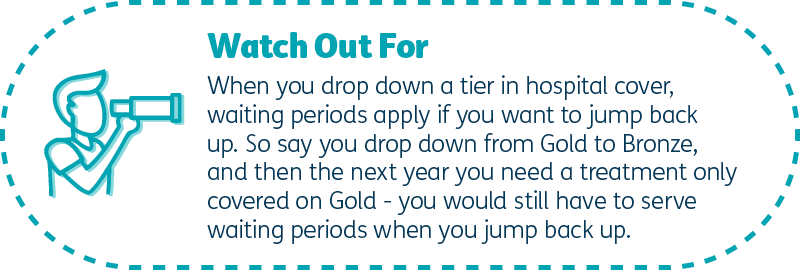Blog article
Comparing health cover – insider tips on getting the most value and peace of mind

That’s why we’re here, sharing some insider tips from our own private health insurance experts on how to compare health insurance options (especially those with similar names) and the lifestyle and health elements that will guide you to your perfect match.
First things first, what’s with all the similar names?
During your research, you may have noticed similar words popping up. With hospital cover, you’ll be seeing a lot of ‘Basic,’ ‘Silver’ ‘Bronze’, and ‘Gold’ on the scene – and probably a ‘Plus’ or two.
While similar names across different funds can allude to similar value, you’re rarely comparing apples with apples when it comes to private health insurance, and this applies to both hospital and extras.
Seeing double? Or triple? Here’s a light dictionary of the words you’ll be seeing over and over, teamed with how they usually differ from fund to fund.
- Basic Hospital - This is the lowest tier, which at a minimum provides restricted cover for Hospital psychiatric services, Palliative care and Rehabilitation. Generally, Basic Hospital cover has the most excluded services making it best suited for people that are young and healthy or are looking for cheaper cover.
- Bronze Hospital - At a minimum, Bronze Hospital must include cover for 18 specific treatment categories, and restricted cover for Hospital psychiatric services, Palliative care and Rehabilitation.
- Silver Hospital - Silver Hospital is the second highest tier of cover. At a minimum, Silver Hospital must include cover for 26 specific treatment categories, and restricted cover for Hospital psychiatric services, Palliative care and Rehabilitation.
- Gold Hospital - Gold Hospital is the highest level of cover. It must include cover for all 38 categories of treatment and services. It’s designed for people who are looking for the fullest cover.
Then comes the ‘plus’. You may notice a ‘plus’ or ‘+’ added to the name of a cover, such as ‘Bronze Hospital Plus’. This is added by individual funds – and not all pluses are created equal. Basically, Health Funds can choose to include more clinical categories in their products than the government's minimum requirement for a tier.
Adding a ‘plus’ shows that the product has additional treatments included, but not all products include the same added services, it can vary depending on which product you choose. When you know what you want to be covered for, you can play the game of pluses.
Keen to learn more about hospital tiers and plus products? Click here.
Learn more about hospital cover and how it works
What about extras you ask? There’s more to come or click here for the run-down.
How to best plan ahead, without a crystal ball
If you’re feeling nervous that you won’t be covered for something you couldn’t possibly predict, you’re not alone. This is a common health insurance hurdle.
While nobody wants to imagine a health crisis in the making – it’s smart to stop and think about some key lifestyle elements and moments in your family history to make the best decision for you or you and your family.
And remember, you’re not locked in, you can update your policy whenever you like.

Now for a checklist of things to think about – no crystal ball necessary.
A Checklist
Grab a pen, it’s time to make a life-list that will help you figure out what you need and compare cover options with clarity.
- Have you thought about your family history? Knowing your family’s health history is a huge advantage when it comes to choosing health cover. Consider speaking to your closest family members about known health issues, from diabetes to under-functioning thyroids to heart problems – knowledge is power and knowing your family history can help you make an informed decision on what sort of cover will give you peace of mind. And if you have kids, don’t forget to consider they may have a need for something you did such as grommets or braces.
- Is peace of mind important to you? It’s hard to plan ahead when it comes to your health, but one thing that’s certain is that circumstances can change quickly. Thinking about whether knowing you’re covered when you need it is something important to you is actually very important when it comes to comparing private health insurance. We’ve got some handy guides on getting health insurance (and peace of mind) in your 30s and 40s.
- Do you have kids? Every parent wants to be able to make quick medical decisions if their child is in need, and going private gives you more comfort in being able to do so.
- Do you play contact sports? Injuries can be expensive and incredibly challenging – especially if you require surgery and follow-up appointments with specialists. Acknowledging risks can help you decide on the best cover for you. This is also where extras come in – you might want a series of remedial massages after a hard season or maybe you’re a hiker and having a regular physio appointment helps keep you feel at your peak for the peaks.
- Are you thinking about starting a family? If you’re considering having a baby in the future and have decided you would like private hospital care or an obstetrician, it’s a good idea to look at waiting periods and add adequate cover to your policy prior to falling pregnant.
- Are you turning 31? Time to learn about the Lifetime Health Cover Loading (LHC) it’s basically where every year you don’t have hospital cover past 31, it becomes more expensive. It’s worth looking into – especially if any of the above apply.
- Have you just got a promotion – If you’re earning above $101,000 as a single or $202,000 as a couple or family, you could avoid at least $1010 in tax by having hospital cover.
Health issues can snowball quickly, and as unlikely as it may feel – thinking about the broader picture of an injury or health crisis, like time off work and lost income if you have to wait a longer time for treatment is worth considering. Both hospital and extras can help you feel covered for the unforeseen, which leads us to our insider tip.

Why you should look at what’s included, but also what’s excluded
It’s easy to get swept up in what’s included without looking into what’s excluded. You see a trail of ticks and think, “looks good to me!” But don’t forget to look into what’s not included, or in the case of hospital cover – what’s restricted.
Let’s split this into extras and hospital.
Extras: Know what’s included and assess whether what’s excluded is something you may need from your checklist of family history and lifestyle factors. Maybe you see that dental is covered, but with your kids approaching teenage years there’s a chance that orthodontic work, like braces, might be on the horizon… so you may want to check whether Orthodontics is included here too.
Hospital: Don’t get caught out by waiting periods. For example, if you’ve already had a joint reconstruction in the past and there’s a chance a replacement may be on the cards in future - it’s important you have cover for joint replacements at least 12 months before you’re going to need that procedure.
Another common mistake to avoid is don’t let your policy sit stagnant. As you age, your lifestyle and health concerns change and it’s important not to do the ol’ ‘set and forget’. A policy health check is easy and helps you avoid nasty surprises.
Understand what the policy covers, and ask as many questions as you need to. If in doubt, call and speak to someone.
What you need to know about waiting periods
All health funds have waiting periods. Waiting periods are exactly what they sound like, a period of time you’re required to wait before you can claim - and we talk about them in detail here.
When it comes to comparing health funds and their waiting periods - you should. They apply to both hospital and extras and while it’s unlikely you’ll find differences between funds, waiting periods are communicated openly and worth taking it into consideration. Especially if there is something you know you will need to claim for in the future.
Waiting periods explained
What you need to know about extras limits and benefits
When comparing funds and what you will get back (your benefit) look closely to make sure the value is serving you and your needs. With extras limits, while you may put two competing policies next to each other and see the same services included and excluded – the limits can be another story.
This is where you need to look at the ‘limit structure’ – do you get a combined limit across a range of services to use flexibly how you like? Or are there separate limits for individual services? There are pros and cons to both, and it’s all about your own health situation.
Meet Max.
Max wasn’t blessed with great gums, after a few years of neglect he wants to keep on top of his teeth and knows preventative dental is important to him. He’s also got super active twin toddlers and knows regular physio is a must too. So, here’s where limits can bite. Having preventative dental as part of a combined limit with other services probably won’t suit Max – as he could end up using the entire limit on dental. Instead, Max is best to opt for a policy with no annual limits for preventative dental and a separate combined annual limit for physio, chiro, osteo and podiatry.
HBF offers this with our Complete 60 policy.
Then looking at benefit back, you should always look at whether you’re getting a guaranteed percentage back on a service (like physio) or if it is a set $ benefit.
A guaranteed % back can provide a level of certainty, which helps people stick to a budget and manage their health costs.
A checklist of questions to help you choose an extras policy
- Have you looked into the services you want to be covered for and what you will get back? This is the most obvious one, and requires you look back on the previous checklist to make sure you know what you need now, and what could pop up.
- Are you bothered by when your limit is reset? Some funds reset member limits at the start of the calendar year, others at the financial year. If this is something that impacts your decision, it’s worth looking into.
- Will you be sharing your extras policy with a partner or family members? This is a big one. When comparing funds, you’ll want to find out whether your annual limit has to be shared or whether you get per-person limits. This can mean the difference between your partner using all the physio cover (right when you’ve put your neck out) or you having your own limit that they can’t mistakenly access.

A note on excess
When you take out hospital cover, you’re generally required to choose an ‘excess’.
What is excess, it sounds scary – right? This is an amount of money you contribute out of your own pocket before you can claim for hospital treatment. You only pay an excess when you or someone on your policy is admitted to the hospital.
When comparing hospital cover options, it’s important to check whether the excess applies to both day and overnight surgeries and how frequently it is payable. With HBF for example, you only pay hospital excess once per person, per calendar year if you’re admitted to hospital.
Confused about which excess option to choose? Think back to your checklist from earlier. If you have a medical condition that may require you to be hospitalised, then you might consider opting for a lower excess to reduce that out-of-pocket expense should you need to be admitted. However, if you’re fit and healthy and think it’s unlikely you will need to be admitted to hospital, you might consider a higher excess which will mean that you pay less for your cover.
Generally speaking: Higher excess means a lower premium.
Again, when it comes to excess it’s all about choosing what’s best for you and your situation.
A note on provider networks for in-hospital treatment
Have you looked into whether the specialists you want to see in relation to your treatment are on the provider network? This applies to those living in WA.
You’ll want to check whether your health fund has a large network of fully covered providers that can help reduce your out-of-pocket expenses for in-hospital treatment. Some funds have a “no gap” agreement, however, under this type of arrangement, the specialist may have the option to opt in or out on a case-by-case basis - which doesn’t always provide a lot of certainty. Specialists on HBF’s fully covered network have agreed to opt-in, which can help minimise your out-of-pocket costs when you go to the hospital.
Hot tip: Before treatment, you should contact us for a health benefit quote – so you know what you’re covered for, the benefits you’ll receive, and any out-of-pocket expenses.
This is, of course, is subject to the annual limits, waiting periods, exclusions, and other terms and conditions of your policy. You should make sure to read these carefully.
In conclusion…
Whether you’re thinking about getting health cover for the first time, wanting to change your current level of cover, or searching for a better deal, it’s important to know how to compare different types of cover to make an informed decision - so make those checklists, write down all your questions and call us any time on 133 423.
Please note: This blog was originally published on 31 July 2023 and has been updated to include the latest information.


